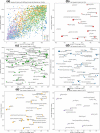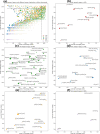An extensive analysis of the presence of altmetric data for Web of Science publications across subject fields and research topics
- PMID: 32836523
- PMCID: PMC7297939
- DOI: 10.1007/s11192-020-03564-9
An extensive analysis of the presence of altmetric data for Web of Science publications across subject fields and research topics
Abstract
Sufficient data presence is one of the key preconditions for applying metrics in practice. Based on both Altmetric.com data and Mendeley data collected up to 2019, this paper presents a state-of-the-art analysis of the presence of 12 kinds of altmetric events for nearly 12.3 million Web of Science publications published between 2012 and 2018. Results show that even though an upward trend of data presence can be observed over time, except for Mendeley readers and Twitter mentions, the overall presence of most altmetric data is still low. The majority of altmetric events go to publications in the fields of Biomedical and Health Sciences, Social Sciences and Humanities, and Life and Earth Sciences. As to research topics, the level of attention received by research topics varies across altmetric data, and specific altmetric data show different preferences for research topics, on the basis of which a framework for identifying hot research topics is proposed and applied to detect research topics with higher levels of attention garnered on certain altmetric data source. Twitter mentions and policy document citations were selected as two examples to identify hot research topics of interest of Twitter users and policy-makers, respectively, shedding light on the potential of altmetric data in monitoring research trends of specific social attention.
Keywords: Altmetrics; Data coverage; Data intensity; Hot topics; Social attention; Social media metrics.
© The Author(s) 2020.
Figures










References
-
- Alperin JP. Geographic variation in social media metrics: An analysis of Latin American journal articles. Aslib Journal of Information Management. 2015;67(3):289–304. doi: 10.1108/AJIM-12-2014-0176. - DOI
-
- Bornmann L. Do altmetrics point to the broader impact of research? An overview of benefits and disadvantages of altmetrics. Journal of Informetrics. 2014;8(4):895–903. doi: 10.1016/j.joi.2014.09.005. - DOI
-
- Bornmann L. Usefulness of altmetrics for measuring the broader impact of research: A case study using data from PLOS and F1000Prime. Aslib Journal of Information Management. 2015;67(3):305–319. doi: 10.1108/AJIM-09-2014-0115. - DOI
-
- Bornmann L. Alternative metrics in scientometrics: A meta-analysis of research into three altmetrics. Scientometrics. 2015;103(3):1123–1144. doi: 10.1007/s11192-015-1565-y. - DOI
-
- Bornmann L. What do altmetrics counts mean? A plea for content analyses. Journal of the Association for Information Science and Technology. 2016;67(4):1016–1017. doi: 10.1002/asi.23633. - DOI
LinkOut - more resources
Full Text Sources
Research Materials
